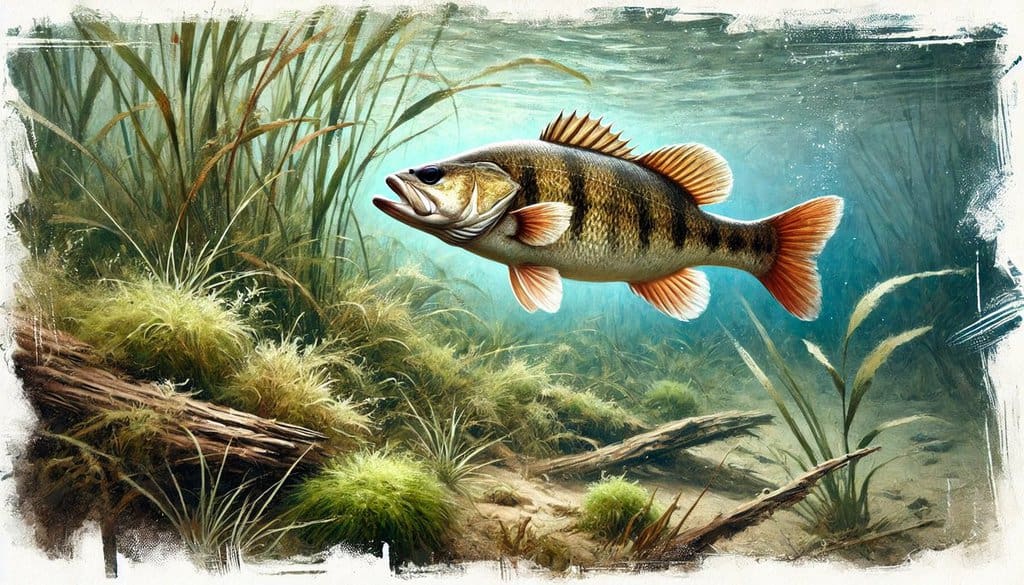Smallmouth Bass (Micropterus dolomieu) is a popular sport fish known for its fighting spirit and delicious taste. In aquaponics, it’s valued for its adaptability and relatively fast growth rate. Smallmouth Bass are resilient and can thrive in various water conditions, making them an attractive option for aquaponics enthusiasts[3][4].
Natural Habitat and Behavior
Origin and native environment: Smallmouth Bass are native to the freshwater streams, rivers, and lakes of eastern and central North America[3].
Natural behavior in the wild: These fish are known for their aggressive feeding habits and prefer cooler, flowing waters. They often inhabit areas with rocky substrates and moderate currents[3].
Temperament: In aquaponics systems, Smallmouth Bass can be territorial and somewhat aggressive, especially during breeding seasons[2].
Compatibility: Due to their predatory nature, Smallmouth Bass are best kept with fish of similar size or in species-specific tanks.
Water Requirements
Temperature Range:
- Ideal temperature: 16-22°C (60.8-71.6°F)
- Effects of temperature extremes: Growth rates decrease significantly below 10°C (50°F) and above 26°C (78.8°F)[5].
pH Level:
- Recommended range: 6.5-8.5
- Smallmouth Bass can tolerate moderate pH fluctuations[3].
Water hardness:
- Prefer moderately hard water, 50-250 ppm CaCO3
Oxygen Levels:
- Ideal dissolved oxygen: >5 mg/L
- Smallmouth Bass are sensitive to low oxygen conditions[5].
Ammonia/Nitrate Sensitivity:
- Sensitive to ammonia and nitrite spikes
- Maintain ammonia below 0.02 ppm and nitrite below 0.1 ppm
Tank or Pond Setup
Tank/Pond Size Requirements:
- Minimum 1000 liters (264 gallons) per adult fish
- Allow 0.1-0.2 m³ (3.5-7 ft³) of water per kg of fish
Filtration & Aeration:
- Require strong filtration and good water circulation
- High aeration is crucial, especially in warmer temperatures[5].
Lighting Considerations:
- Natural light cycles are sufficient; avoid excessive direct sunlight
Tank Decorations/Substrate:
- Include rocky substrates and structures for hiding
- Incorporate plants for cover and natural filtration
Feeding Requirements
Diet:
- Carnivorous; prefer live prey but will accept pellets
- High-protein diets are essential for optimal growth[1].
Feeding Techniques:
- Feed 2-3 times daily for juveniles, 1-2 times for adults
- Offer a variety of foods including fish pellets, insects, and small fish
Supplements or special diets:
- Protein requirements: 45-46% of dry diet for optimal growth[1].
Growth and Reproduction
Growth Rate:
- Can reach 280 mm (11 inches) total length by age 4[4].
- Growth rates vary based on environmental conditions and food availability.
Physical Growth Indicators:
- Develop darker vertical bars on sides as they mature
Breeding Behavior:
- Spawn in spring when water temperatures reach 15-18°C (59-64.4°F)
- Males build nests in gravel areas and guard eggs
Care of Fry:
- Fry require zooplankton and small insects
- Protect fry from cannibalism by adults
Harvesting & Culinary Considerations
Growth to Harvest:
- Typically harvested at 30-40 cm (12-16 inches)
- Takes about 2-3 years to reach harvest size in aquaponics
Culinary Uses:
- Mild, white flesh with a sweet flavor
- Best prepared grilled, baked, or pan-fried
Recommendations for Ethical Harvesting:
- Use humane methods like rapid chilling or percussive stunning
Pros and Cons
- Adaptable to various water conditions
- Efficient feed conversion
- Popular for both food and sport fishing
- Require larger system sizes
- Can be aggressive towards other fish
- Sensitive to low oxygen levels
Overall Suitability:
- Best for intermediate to advanced aquaponics practitioners with larger systems
Common Health Issues and Solutions
Potential Diseases:
- Susceptible to bacterial infections and parasites
- Stress-induced diseases in suboptimal conditions
Signs of Health Issues:
- Lethargy, loss of appetite, abnormal swimming patterns
Treatment Recommendations:
- Maintain optimal water quality
- Consult a fish veterinarian for specific treatments
Maintenance Tips for Long-Term Health
Maintenance Frequency:
- Weekly water quality checks
- Regular system cleaning and filter maintenance
System checks:
- Monitor temperature, dissolved oxygen, and pH daily
- Check ammonia and nitrite levels weekly
Handling Practices:
- Minimize handling; use nets when necessary
- Avoid sudden temperature changes when moving fish
Winter/Summer Care:
- Provide consistent temperatures year-round
- Increase aeration during warmer months
Tank Compatibility and Stocking:
- Best kept in species-specific systems
- Compatible with hardy plants that can withstand some disturbance
Closing Thoughts
Smallmouth Bass can be a rewarding species for aquaponics enthusiasts with larger systems and experience in fish husbandry. Their adaptability and growth rates make them suitable for both ornamental and food production purposes. However, their size and environmental requirements demand careful system design and management.
Other fish species for aquaponics
External sources:
[1] https://pubmed.ncbi.nlm.nih.gov/7241229/
[2] https://www.semanticscholar.org/paper/22adccc0d4d6dbebdd60285d9f1e194f4146492f
[3] https://www.semanticscholar.org/paper/2753fd232d84984345ca04be3edb63b9d8e2a9bb
[4] https://www.semanticscholar.org/paper/574e55254eb84ac18f82f6a60b71e439bd8835dc
[5] https://pubmed.ncbi.nlm.nih.gov/38720527/
[6] https://www.ncbi.nlm.nih.gov/pmc/articles/PMC9729326/

